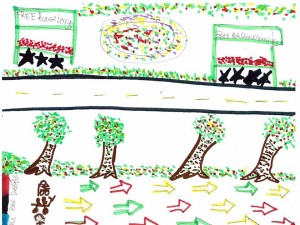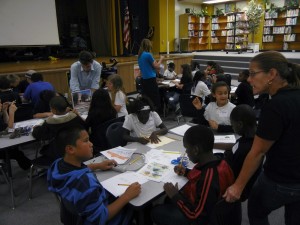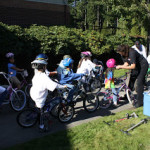This post originally appeared on The Congress for the New Urbanism’s blog, CNU.org/salons. The post was written by Nicholas Richter and Josh Jorgensen, planning interns for the City of Tacoma.
THE PROJECT
What started as a project for two planning interns with the City of Tacoma has turned into a transformational partnership between the City of Tacoma, McCarver Elementary School, and many other local community organizations and firms.
The project brought planning to the classroom with a series of activities including visioning exercises and charrettes that focused on neighborhood safety and what community meant to elementary school children. As part of these activities, children were asked to illustrate their ideas and these drawings were the inspiration for a complete streets primer specifically for the neighborhood where the school is located, called “35 Ways to Safer Neighborhood Streets”.
The complete street primer (available here) is a natural extension of the City of Tacoma’s award winning citywide complete street guidelines. The booklet covers 35 specific traffic calming treatments and programs available to the local community. The inspiration for the booklet came after seeing that many pictures that the school children had drawn were directly related to real engineering solutions that are used in communities around the country to ensure that traffic on residential streets stay at residential speeds.
The end result of their efforts is a 60 page, full color guide to some of the most effective treatments outlined by leading bike and pedestrian development guides, complete with local examples and illustrations by the children at McCarver Elementary School. The booklet also includes a planner supplement at the end that outlines some of the key takeaways from the experience of working in a classroom setting.
THE MESSAGE
The way our streets are designed greatly influences the way we interact socially. Safe streets directly contribute to a child’s ability to independently get around their own neighborhood by providing a safe environment for walking, biking, and play. Therefore, if streets are not complete, they are “incomplete.”
The danger that incomplete streets pose to children has always been a concern across the nation, but until recently instead of progressively prioritizing those with limited abilities or developmental restrictions, such as children, we have prioritized vehicle speeds and volumes. Among the children that participated in charrettes at McCarver, many were excited about the idea of having access to places where they felt comfortable walking and biking, both as a safe routes to their school and as safe way to get to their friend’s house, the park, or other places they wanted to be.
The City of Tacoma is currently working on a subarea plan for the MLK District, where McCarver Elementary School is located. The plan envisions a well-connected, mixed-use neighborhood with strong multimodal connections to other areas of Tacoma. The “35 Ways to Safer Neighborhood Streets” booklet aims to highlight the great work done by the children at McCarver Elementary School while also providing local residents with an introduction to neighborhood traffic calming tools and complete street concepts.
Top 3 Takeaways for Involving Children in Planning at the Classroom Level
- Engage students — make sure the material you are presenting is grade appropriate and fun. Lessons that are too hard or too easy for students will leave them frustrated or bored, which will be palpable. If you’re unsure about this, discuss with the teacher prior to your visit.
- You are a visitor — classroom management is difficult when you do not know the kids or are familiar with their routines. The more engaged the students are, the fewer problems you will have.
- Praise, praise, praise. — Leave the classroom in the same or better mood than you arrived! Keep it as positive as possible! Students are more likely to follow directions and stay on task if they feel like you like them! Praising students and making them feel good about themselves will leave a good impression on the teacher and the kids.
More tips on working with children in planning work can be found starting on page 53 of “35 Ways to Safe Neighborhood Streets”, available here: http://www.cityoftacoma.org/MLKPlan-McCarver






One Trackback
[…] Richter of Central Seattle Greenways led the effort to produce a City of Tacoma “Childrens’ Guide to Complete Streets.” Nice […]